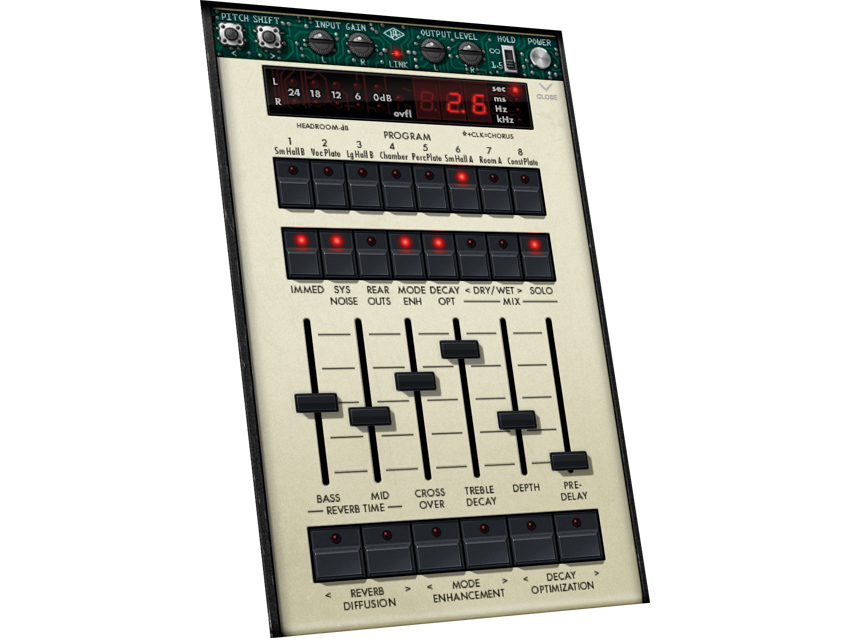MusicRadar Verdict
A faithful and simply sumptuous-sounding Lexicon 224 emulation. Soon to be a go-to reverb.
Pros
- +
Gorgeous sound. More flexible than it first appears. Capable of enhancing a wide range of material.
Cons
- -
Nothing, really.
MusicRadar's got your back
Never a company to shirk software emulations of the world's most popular hardware, UAD's latest software update, Version 5.9, contains a re-make of Lexicon's 224 digital reverb unit.
Released in 1979, this is the best-selling digital reverb of all time and has made its mark on a diverse range of records.
Slide me to heaven
The 224 reverb was a famously tactile beast, with six sliders in its lower section to control independent reverb for Bass and Mid frequencies, Crossover, Treble Decay time, Reverb Depth and Pre-Delay.
"All nine algorithms from the 224's final incarnation are present."
All nine algorithms from the 224's final incarnation are present - two variations of Small Hall, Vocal Plate, Large Hall, Chamber, Percussion Plate, Room and Constant Density plate, the latter of which maintains Density through the reverb tail rather than progressively adding it as most digital reverbs do.
Additionally, there's an algorithm for the 224's Chorus that can be activated either via a control-click or a button above the main program algorithm switches.
The Crossover slider allows you to determine which frequencies qualify as 'Bass' or 'Mid', so there's a huge range of flexibility, regardless of which reverb type you select.
Faithful to the original as ever, LEDs at the top indicate input level and while it's possible to over-cook this by default, a quick click of the 'Open' button on the GUI's right launches an additional panel, which allows you to boost or cut levels.
Also here, you can adjust Output Level, bypass the plug-in via its Power button and even choose whether the display will 'hold' the most recently adjusted parameter's value or, as with the original hardware, display modified values for one-and-a-half seconds only.
Mode enhancements
The flexibility of the 224 was encapsulated in part by Mode Enhancement, which offered a simple way to tame and preserve 'naturalness' in the reverb tail. This can be recreated via UAD's emulation but additional parameters, in the form of the Pitch Shift left and right buttons, which allow you to control exactly what happens when Mode Enhancement is engaged.
There are 16 options here, with lower settings providing mild pitch modulation of the reverb tail and higher settings producing more extreme detuning effects, providing a vintage treatment that will intrigue sound designers.
At first glance, UAD's 224 looks like a simple affair, but there's an extraordinary amount of flexibility under the hood. Having every function accessible from a single panel means that tailoring a reverb to your track is intuitive and quick, yet there's plenty here to keep more serious tweakers happy, too.
The sound is everything you could hope for - warm, rich, lush and mix-enhancing.
Future Music is the number one magazine for today's producers. Packed with technique and technology we'll help you make great new music. All-access artist interviews, in-depth gear reviews, essential production tutorials and much more. Every marvellous monthly edition features reliable reviews of the latest and greatest hardware and software technology and techniques, unparalleled advice, in-depth interviews, sensational free samples and so much more to improve the experience and outcome of your music-making.
“Chinese Democracy was a boring record. But calling it Guns N' Roses was not honest. It was totally a solo record”: GN’R’s ex manager takes aim at Axl Rose
“Instead of labouring over a perfect recreation, we decided to make an expanded counterpart”: Chase Bliss teams up with Mike Piera for Analog Man collab based on the legendary King Of Tone
“It’s about delivering the most in-demand mods straight from the factory”: Fender hot-rods itself as the Player II Modified Series rolls out the upgrades – and it got IDLES to demo them











